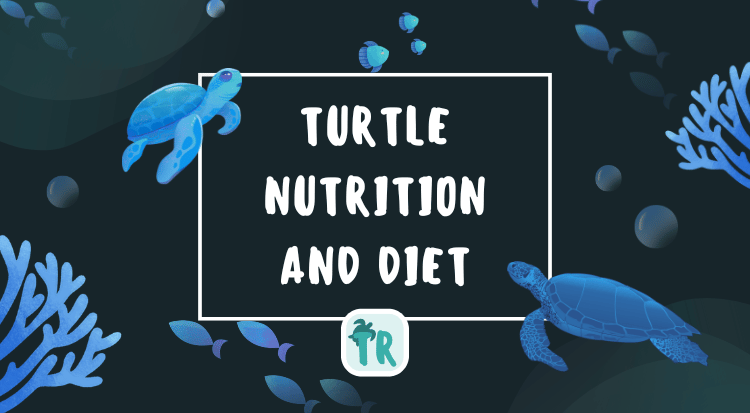Turtle Nutrition and Diet Guide

Understanding and meeting the nutritional needs of your pet turtle is crucial for their health and well-being. This comprehensive guide on turtle nutrition, including feeding schedules, types of food, supplements, and dietary needs based on species and age, will empower you to keep your shelled friend healthy and thriving.
Understanding Turtle Dietary Needs
Different turtle species have varying dietary requirements based on their natural habitats.
Herbivores, Carnivores, and Omnivores
- Herbivorous Turtles: Eat mostly plants. Examples include some tortoises and green sea turtles.
- Carnivorous Turtles: Eat mainly meat. Examples include snapping turtles.
- Omnivorous Turtles: Eat both plants and animals. Most pet turtles, like red-eared sliders and box turtles, fall into this category.
Importance of a Balanced Diet
A balanced diet ensures your turtle gets all the necessary nutrients:
- Proteins: For growth and repair.
- Fats: Provide energy.
- Carbohydrates: Supply additional energy.
- Vitamins and Minerals: Support overall health.
Feeding Schedules
Establishing and maintaining a regular feeding schedule is a key factor in your turtle's well-being. This consistency helps them anticipate and prepare for their meals, contributing to their overall health and happiness.
Feeding Frequency
- Hatchlings and Juveniles: Feed daily to support growth.
- Adult Turtles: Feed every other day or 3-4 times a week, depending on species.
Best Times to Feed
- Morning or Afternoon: Aligns with turtles' natural feeding times.
- After Basking: Turtles often eat after warming up.
Portion Sizes
- General Rule: Offer an amount of food about the size of your turtle's head.
- Adjust as Needed: Monitor your turtle's weight and adjust portions accordingly.
Commercial Turtle Foods
Commercial foods can be a convenient and nutritious part of your turtle's diet.
Types of Commercial Foods
- Pellets: Formulated for balanced nutrition.
- Sticks: Similar to pellets but in stick form.
- Freeze-Dried Foods: Such as shrimp or mealworms.
Choosing the Right Product
- Species-Specific Formulas: Select foods designed for your turtle's species.
- Quality Ingredients: Look for natural ingredients without fillers.
- Trusted Brands: Choose reputable brands known for quality.
Feeding Guidelines
- Follow Instructions: Use the manufacturer's recommendations.
- Supplement with Fresh Foods: Combine with fresh options for variety.
Fresh Foods for Turtles
Adding a variety of fresh foods to your turtle's diet not only provides essential nutrients but also adds a sense of adventure and creativity to their meals. This variety can include a range of vegetables, fruits, and proteins, offering a diverse and interesting diet for your pet.
Vegetables
- Leafy Greens: Kale, collard greens, dandelion greens, romaine lettuce.
- Other Veggies: Shredded carrots, squash, bell peppers.
Fruits
- Occasional Treats: Strawberries, blueberries, melon.
- Limit Amounts: Due to high sugar content.
Proteins
- Animal Proteins: Cooked chicken, earthworms, crickets, mealworms.
- Aquatic Options: Feeder fish (for larger turtles), shrimp, snails.
Feeding Tips
- Wash Thoroughly: Remove pesticides and dirt.
- Cut into Small Pieces: Easier for your turtle to eat.
- Remove Uneaten Food: Prevents spoilage and keeps the habitat clean.
Vitamin and Mineral Supplements
Supplements help ensure your turtle gets all the necessary nutrients.
Calcium
- Importance: Essential for shell and bone health.
- Sources: Cuttlebone in the tank, calcium powder on food.
Vitamin D3
- Role: Helps absorb calcium.
- UVB Lighting: Necessary for turtles to produce vitamin D3.
- Supplements: Included in some multivitamin powders.
Multivitamins
- Purpose: Provide a range of vitamins and minerals.
- Usage: Sprinkle on food once or twice a week.
Caution
- Avoid Overuse: Too many vitamins can be harmful.
- Consult a Vet: If unsure about supplement needs.
Dietary Needs by Species
Different species have specific dietary requirements.
Red-Eared Sliders
- Diet: Omnivorous; balanced mix of plants and proteins.
- Favorites: Aquatic plants, insects, pellets.
Box Turtles
- Diet: Omnivorous with more insects and fruits.
- Favorites: Earthworms, berries, leafy greens.
Painted Turtles
- Diet: Omnivorous, more carnivorous when young.
- Favorites: Small fish, insects, aquatic plants.
Tortoises
- Diet: Primarily herbivorous.
- Favorites: Grasses, hay, leafy greens.
Feeding Young vs. Adult Turtles
Nutritional needs change as turtles grow.
Hatchlings and Juveniles
- Higher Protein Needs: Supports rapid growth.
- Daily Feeding: Offer food every day.
- Calcium Intake: Important for shell development.
Adult Turtles
- Balanced Diet: More plant matter for omnivores.
- Feeding Frequency: Every other day or as appropriate.
- Weight Monitoring: Adjust diet to prevent obesity.
Common Feeding Mistakes to Avoid
Avoiding mistakes helps keep your turtle healthy.
Overfeeding
- Risks: It can cause obesity and health issues.
- Solution: Stick to portion guidelines and schedules.
Lack of Variety
- Risks: Leads to nutritional deficiencies.
- Solution: Provide a mix of foods.
Improper Supplements
- Risks: Overdosing or deficiencies.
- Solution: Use supplements as directed.
Feeding Unsafe Foods
- Avoid: Processed foods, dairy, and toxic plants.
- Solution: Stick to recommended turtle foods.
Conclusion
Providing a proper diet is one of the most important parts of turtle care. By understanding your turtle's needs, offering a balanced mix of foods, and following feeding schedules, you can ensure your turtle stays healthy and happy. Always watch for changes in appetite or behavior, and remember, it's okay to ask for help. Consulting a veterinarian if you have concerns is not a sign of weakness, but a responsible action that can reassure you about your pet's health.